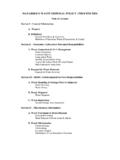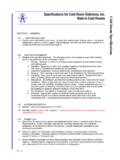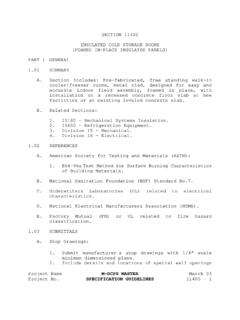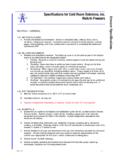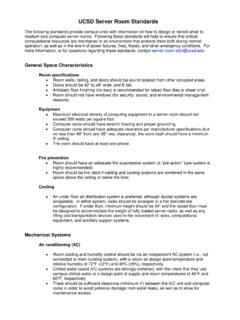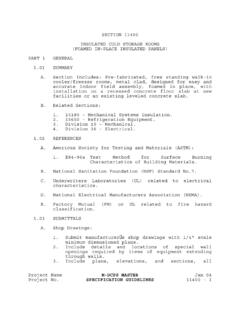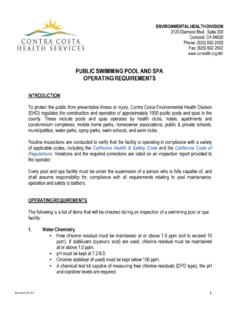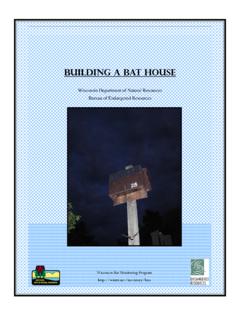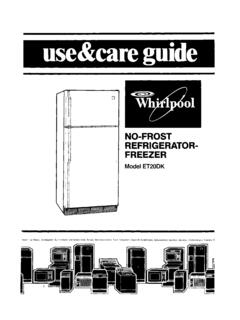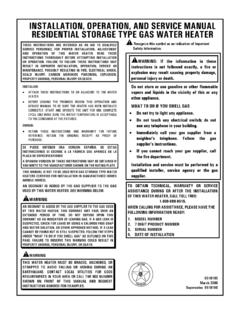Transcription of LABORATORY FUME HOOD SPECIFICATIONS
1 LABORATORY fume hood SPECIFICATIONSA. GENERAL DESCRIPTIONAll new hoods shall meet testing criteria established by the American Society of Heating, Refrigerating, andAir Conditioning Engineers, Inc. (ASHRAE) in ANSI/ASHRAE 110-1995, Method of Testing Performanceof LABORATORY fume Hoods. All LABORATORY fume hoods ( standard, bench, distillation, walk-in) shall haveproper aerodynamic design to minimize eddy currents and assure against air movement from the hood into thelaboratory. The design shall include airfoil sides and an aerodynamic sill with a 1-inch air gap between the silland the hood floor. An air by-pass shall be present on all hoods to control the range of the face velocity asthe hood sash is raised and lowered. The face velocity at any sash position should never exceed three times the open face velocity. It is necessary to keep the air velocities within this range to reduce eddy currents aroundthe edges of the hood LOCATIONAll new fume hoods shall be an integral part of the LABORATORY design and all LABORATORY renovations shall alsorectify improper hood hoods shall be located in a room so that air currents generated in the room will not interfere with thehood s ability to capture and eliminate vapors, mists, and airborne particles.
2 Therefore, hoods shall be locatedas far away as possible from:1. Doors2. Supply air diffusers3. Windows which can be opened4. Heavy traffic areas5. Other location exhaust ventilation devicesRoom air current velocities at the face of the hood should not exceed twenty linear feet per minute (LFM) fromany source and should be as close to zero as hood DESIGN AND CONSTRUCTIONIn general, all fume hoods should be constructed and contain materials that will permit their planned use to becarried out safely; therefore, their intended use must be sidewalls shall be 3 - 6 inches wide, and shall be properly formed to present a smooth airfoil to theinflowing air. The hood interior lining shall be flush with the sides. These features shall, over the range of thehood s designed air face velocity, prevent significant eddy currents from circulating air from inside the hoodthrough the plane of the face of the radiused stainless steel sill is required.
3 It shall be installed at the bottom of the hood opening and extendback under the sash. An open area of approximately 1 inch shall be present under the sill to direct air acrossthe work surface at all sash sash may be vertically or horizontally tracked. Horizontal sash hoods shall have a device to lock the sashin its tracks. Removal of the sash must only be possible with special tools or keys. Glass used in the sash shallbe at least 7/32 inches thick combination sheet. The sash shall be securely enclosed in a complete frame,welded and ground smooth at the corners. Stainless steel or a baked-on epoxy coat is to be used for the sashframe. Vertical sashes shall be counter-balanced with sash weights, suspended from each side of the sash andshall be easily operated. The sash frame must be held in a stainless steel track and have plastic interior lining of the hood must be resistant to the materials and chemicals to which it will be steel is acceptable; suitable compositions, including transite, must be painted or coated withimpervious sealer such as epoxy paint.
4 The selection of resistant materials must be made through consultationwith the Rutgers Environmental Health and Safety Department (REHS).Use of perchloric acid, hydrofluoric acid, and radioisotopes require special consideration as detailed in rolled steel shall be used for the hood exterior. All parts shall be joined together with screws to allow fordismantling and access for service. After fabrication and before final assembly, all component parts shall begiven an acid, alkali and solvent resistant finish on both exterior and interior full rigid frame shall support the interior and exterior walls of the fume SurfaceThe working surface shall be molded epoxy or stainless steel. It shall be recessed not less than inch deepand have a raised area on all sides. The raised area across the front of the hood shall be at least three Fixtures and ServicesThe user shall specify utility service needs. Electric service shall be located on the exterior of the fixtures shall be brass, chrome-plated, or acid and organic vapor resistant plastic.
5 All fixtures shallhave color-coded end caps. All controls for plumbing services shall be located on the hood shall be equipped with sufficient fluorescent or incandescent lighting. The light fixture shall be easilyaccessible from the outside of the hood , shall be shielded from the hood interior by a laminated or temperedglass panel, and shall be vapor By-Pass MechanismAll hoods shall be equipped with an air by-pass mechanism located above the hood face opening. It shallprovide an effective sight-tight barrier between the user and the hood interior. By-pass louvers shall bedirected upward away from the front of the hood and provide an effective barrier and deflector for flying debrisfrom inside the hood . The by-pass shall control the face velocity as the sash is lowered. The velocity of the airat any sash position shall never exceed three times the open face velocity. The air by-pass shall begin tooperate when the sash is one-third to one-half and Slot ArrangementA plenum shall be located in the rear of all fume hoods.
6 It must have at least two but no more than three lower slot shall be furnished at the working surface level and be locked at 2 to 2 inches or have thebaffle removed entirely. The upper slot shall be located in the upper section of the hood . The opening shall beset at 3/8 to inch maximum. A middle slot, if furnished, shall be fixed and have an opening no greater than MOTORSE xhaust motors and duct systems for hoods are to be sized and designed to provide an average hood facevelocity of 80-100 LFM, as measured at the face, with the sash wide open. Deviations in this value shall notbe greater than 20% at any point across the hood face. To assure this standard, the designer must work closelywith the duct installer to determine the effects of duct routing on motor motors shall be located on the roof, or in an adequately ventilated fan loft. Exhaust motors shall belocated to allow access for Velocity Control SystemThe fume hood shall be equipped with a device to measure and monitor airflow.
7 At a minimum, the systemshall have a visual indicator of the hood face velocity. Additionally, adjustable low flow/caution alarmsetpoints with audible buzzer or alarm are recommended. The system chosen shall be approved by DUCT DESIGN AND CONSTRUCTIOND ucts shall be constructed of materials compatible with the chemicals being used in the hood . Circularductwork is preferable to other shapes as it reduces friction loss and is easier to are usually constructed of galvanized sheet steel, riveted and sealed. If reactive chemicals will be used,ducts shall be constructed of a non-reactive stainless steel, unplasticized PVC, or have an inorganic ceramiccoating. Questions about duct composition should be referred to shall take the straightest route to the roof, minimizing bends and horizontal runs. Increaseddistances and bends create resistance to airflow and require exhaust motors. When elbows are necessary, theyshall have proper centerline radius (1 times the diameter of the ducts) to minimize eddying and resistance toair flow.
8 All elbows shall have removable wear plates when operations will involve heavy dust shall not enter the exhaust motor on an elbow. Exhaust motors shall be located on the roof so that anegative pressure will be maintained in the ductwork and prevent escape of toxic material through holes andcracks in the or charcoal filters are not required for most routine uses of fume hoods. Install a filter or filter housingonly if specified by REHS. Where filters are required, the housing shall be located in the fan room or roofbefore the blower. The filter housing shall be located to allow for easy filter changing by the bag-in/bag-outtechnique. Exhaust fans shall be sized accordingly to handle the increased pressure drop across the deviation from the original SPECIFICATIONS required in the routing of ductwork during installation shall beconsidered by an engineer to assure that the change will not alter the designed performance of the DISCHARGEThe discharge point must be at a proper height above the highest point of the roof or parapet (10-15 ft.)
9 Toreduce air streaming effects of the building. Air shall be discharged vertically with at least 3500 feet perminute stack discharge velocity. The discharge stack should be located in the prevailing downwind directionof the air intake discharge stack shall be uncapped, straight, and cylindrical. The discharge duct shall overlap the fanductwork 6 inches and have a 1 inch greater diameter, to provide for rain drip discharge. Deflecting weathercaps are prohibited on discharge stacks, as they reduce the effective stack height, reduce air velocity, and arenot effective rain shields, and increase final SPECIAL HOODSP erchloric Acid HoodTo safely contain perchloric acid, work requirements in addition to the standard design for fume hoods arespecified under this :Materials of construction for the hood and ductwork shall be non-reactive, acid resistant and relativelyimpervious.
10 Type 316 stainless steel, with welded joints, is preferred. Unplasticized PVC or an inorganicceramic coating such as porcelain is interior surfaces of the hood and ductwork shall be smooth and seamless, and constructed for easycleaning. The work surface shall be smooth and watertight with a minimum of inch dished front and sidesand an integral trough at the rear to collect wash-down water. The hood shall be designed to allow easy visualinspection of all interior and Exhaust Fans:Each perchloric acid hood shall have an individual exhaust system ( individual duct to individual fan). Theductwork shall go straight from the hood to the roof with no horizontal runs or sharp turns. Wash-down facilities shall be built into the hood and ductwork. An air ejector system or an exhaust fan may be used. Anair ejector exhaust system eliminates the possibility of acid reaction with fan components and allows for easeof cleaning.
